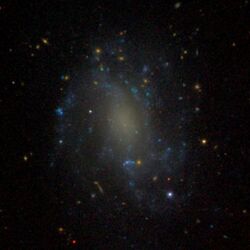Astronomy:NGC 4393
| NGC 4393 | |
|---|---|
 SDSS image of NGC 4393. | |
| Observation data (J2000 epoch) | |
| Constellation | Coma Berenices |
| Right ascension | 12h 25m 51.2s[1] |
| Declination | 27° 33′ 42″[1] |
| Redshift | 0.002505[1] |
| Helio radial velocity | 751 km/s[1] |
| Distance | 46 Mly (14.2 Mpc)[1] |
| Group or cluster | Coma I (NGC 4274 subgroup) |
| Apparent magnitude (V) | 12.7[1] |
| Characteristics | |
| Type | SABd[1] |
| Size | ~38,700 ly (11.86 kpc) (estimated)[1] |
| Apparent size (V) | 3.2 x 3.0[1] |
| Other designations | |
| UGC 07521, PGC 040600, MCG +05-29-083[1] | |
NGC 4393 is a spiral galaxy about 46 million light-years away[2] in the constellation Coma Berenices. It was discovered by astronomer William Herschel on April 11, 1785.[3] It is a member of the NGC 4274 Group,[4][5] which is part of the Coma I Group[6] or Cloud.[7]
Physical characteristics
NGC 4393 is a flocculent spiral galaxy,[8][9] with chaotic, fragmented and unsymmetric arms.[9] IC 3329, an HII region in NGC 4393,[10] was discovered by astronomer Max Wolf on March 23, 1903. It was described as "very faint, small, irregular figure, attached to (NGC) 4393".[11]
NGC 4393 hosts a pseudo-bulge,[12] a type of galactic bulge which is more similar to a spiral galaxy in that it has one or more characteristics of disk galaxies. These include having flatter shapes than those of classical bulges, large ratios of ordered motions of stars rather than random motions of stars, small velocity dispersions of stars with respect to the Faber-Jackson correlation between velocity dispersion and bulge luminosity, a spiral structure or nuclear bar in the bulge part of the light profile, nearly exponential brightness profiles, and starbursts.[13]
Nuclear Star Cluster
The central region of NGC 4393 is host to a nuclear star cluster[14] with a mass of 0.4048 ± 0.0819 × 106 M☉,[15] and a diameter of ~16 ly (4.8 pc).[16]
See also
References
- ↑ 1.0 1.1 1.2 1.3 1.4 1.5 1.6 1.7 1.8 1.9 "NASA/IPAC Extragalactic Database". Results for NGC 4393. http://nedwww.ipac.caltech.edu/. Retrieved 2022-04-18.
- ↑ "Your NED Search Results". https://ned.ipac.caltech.edu/cgi-bin/nph-objsearch?objname=NGC%204393&extend=no&out_csys=Equatorial&out_equinox=J2000.0&obj_sort=RA+or+Longitude&of=pre_text&zv_breaker=30000.0&list_limit=5&img_stamp=YES.
- ↑ "New General Catalog Objects: NGC 4350 - 4399". https://cseligman.com/text/atlas/ngc43a.htm#4393.
- ↑ Kourkchi, Ehsan; Tully, R. Brent (2017-06-27). "Galaxy Groups Within 3500 km s −1". The Astrophysical Journal 843 (1): 16. doi:10.3847/1538-4357/aa76db. ISSN 1538-4357. Bibcode: 2017ApJ...843...16K.
- ↑ "The Extragalactic Distance Database (EDD)". http://edd.ifa.hawaii.edu/.
- ↑ "Nearby Groups of Galaxies". http://ned.ipac.caltech.edu/level5/Dev2/frames.html.
- ↑ Gregory, Stephen A.; Thompson, Laird A. (1977-04-01). "The Coma i Galaxy Cloud". The Astrophysical Journal 213: 345–350. doi:10.1086/155160. ISSN 0004-637X. Bibcode: 1977ApJ...213..345G. https://ui.adsabs.harvard.edu/abs/1977ApJ...213..345G.
- ↑ Elmegreen, D. M.; Elmegreen, B. G. (1982-12-01). "Flocculent and grand design spiral structure in field, binary and group galaxies" (in en). Monthly Notices of the Royal Astronomical Society 201 (4): 1021–1034. doi:10.1093/mnras/201.4.1021. ISSN 0035-8711.
- ↑ 9.0 9.1 Elmegreen, Debra Meloy; Elmegreen, Bruce G. (March 1987). "Arm classifications for spiral galaxies" (in en). The Astrophysical Journal 314: 3. doi:10.1086/165034. ISSN 0004-637X. Bibcode: 1987ApJ...314....3E. http://adsabs.harvard.edu/doi/10.1086/165034.
- ↑ "Your NED Search Results". https://ned.ipac.caltech.edu/cgi-bin/objsearch?objname=IC+3329&extend=no&hconst=73&omegam=0.27&omegav=0.73&corr_z=1&out_csys=Equatorial&out_equinox=J2000.0&obj_sort=RA+or+Longitude&of=pre_text&zv_breaker=30000.0&list_limit=5&img_stamp=YES.
- ↑ "Index Catalog Objects: IC 3300 - 3349". https://cseligman.com/text/atlas/ic33.htm#ic3329.
- ↑ Vaghmare, Kaustubh; Barway, Sudhanshu; Mathur, Smita; Kembhavi, Ajit K. (2015-06-11). "Spiral galaxies as progenitors of pseudo-bulge hosting S0s" (in en). Monthly Notices of the Royal Astronomical Society 450 (1): 873–882. doi:10.1093/mnras/stv668. ISSN 0035-8711. http://academic.oup.com/mnras/article/450/1/873/1009018/Spiral-galaxies-as-progenitors-of-pseudobulge.
- ↑ Kormendy, John; Kennicutt, Robert C. (2004-09-22). "Secular Evolution and the Formation of Pseudobulges in Disk Galaxies" (in en). Annual Review of Astronomy and Astrophysics 42 (1): 603–683. doi:10.1146/annurev.astro.42.053102.134024. ISSN 0066-4146. Bibcode: 2004ARA&A..42..603K. https://www.annualreviews.org/doi/10.1146/annurev.astro.42.053102.134024.
- ↑ Georgiev, Iskren Y.; Böker, Torsten (2014-07-11). "Nuclear star clusters in 228 spiral galaxies in the HST/WFPC2 archive: catalogue and comparison to other stellar systems" (in en). Monthly Notices of the Royal Astronomical Society 441 (4): 3570–3590. doi:10.1093/mnras/stu797. ISSN 1365-2966. http://academic.oup.com/mnras/article/441/4/3570/1222248/Nuclear-star-clusters-in-228-spiral-galaxies-in.
- ↑ Leigh, Nathan W. C.; Georgiev, Iskren Y.; Böker, Torsten; Knigge, Christian; den Brok, Mark (2015-07-21). "Nuclear star cluster formation in energy-space" (in en). Monthly Notices of the Royal Astronomical Society 451 (1): 859–869. doi:10.1093/mnras/stv1012. ISSN 1365-2966. http://academic.oup.com/mnras/article/451/1/859/1345098/Nuclear-star-cluster-formation-in-energyspace.
- ↑ Georgiev, Iskren Y.; Böker, Torsten; Leigh, Nathan; Lützgendorf, Nora; Neumayer, Nadine (2016-04-01). "Masses and scaling relations for nuclear star clusters, and their co-existence with central black holes" (in en). Monthly Notices of the Royal Astronomical Society 457 (2): 2122–2138. doi:10.1093/mnras/stw093. ISSN 0035-8711.
External links
- NGC 4393 on WikiSky: DSS2, SDSS, GALEX, IRAS, Hydrogen α, X-Ray, Astrophoto, Sky Map, Articles and images
 |

